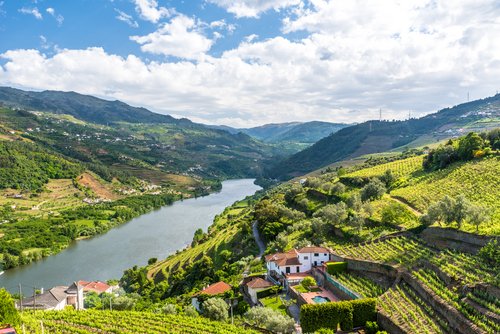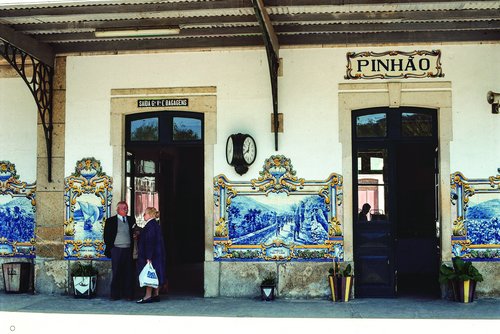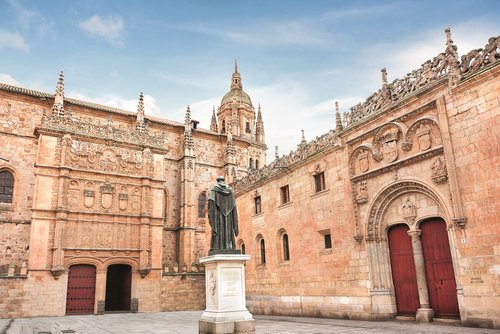A-ROSA on the Douro.
What is the first thing that comes to mind when you think of Portugal? Impressive cliffs, the taste of port wine or fado melodies?
Portugal has it all. Come aboard, discover the beauty of the Douro river, and explore Portugal’s soul! Our A-ROSA ALVA will take you there to get to know the country and its people.
City Hopping starting in Porto
Our Douro cruises begin and end in the city of Porto. So, you will have plenty of time to stroll through the beautiful old town, enjoy the view from Portugal's highest church tower or taste one of the 365 Bacalhau dishes, Portugal's famous dried fish. A trip to the Spanish city Salamanca, which is an UNESCO World Heritage Site, and a visit of the university from the 13th century should not to be missed.
The Golden Douro.
The Douro river formed beautiful valleys with rocky cliff areas, green hills, fields with cork oaks and olive trees and, of course, the magnificent vineyards slopes.
The villages of Vila Real, Lamego and Peso da Régua are all surrounded by Alto Douro, the home of port wine. It is the oldest wine-growing region in the world and also a UNESCO World Heritage Site. Here you can also find the traditional Quintas. Enjoy a wine tasting and see for yourself why this sweet port wine is so popular all over the world.

Douro Cruises in 2025

A-ROSA ON THE DOURO:
- 7 NIGHTS CRUISE
- TRAVEL DATES March to November
- FULLBOARDPLUS
We will offer something special in our restaurant: You can choose starters and desserts from the wonderful buffet, the main courses are served at the table. - INCLUDING ALL THE BEVERAGES YOU LIKE
Tea, water, soft drinks, sparkling wine as well as a selection of wine & beer, during bar opening hours. - COMFORTABLE CABINS
Modern cabins that make your stay on board a pleasant experience. If possible, even in the cabin of your choice. - MANY MORE ADVANTAGES AND SERVICES
e.g. reduced prices on wellness and beauty treatments at SPA‑ROSA.
A-ROSA on the Douro
Highlights along the Douro:

Régua
Régua is the largest town on the banks of the Douro River in this winegrowing valley. The scenic charm of the region stems from the original river that meanders along steep slate slopes and terraces where the wine grows. It is so beautiful here that the Alto Douro has been a UNESCO World Heritage Site since 2001. As early as the 18th century, the city played a decisive role in the production and marketing of port wine, which was transported away from here on sailing ships. To find out more, visit the Douro Museum, which provides comprehensive information on the world's first protected wine-growing area. Then take a walk to the popular São Leonardo da Galafura and São Salvador do Mundo lookout points and enjoy the panorama of the river landscape and the elegant bridges leading into the city. You can also visit the old centre, situated a little uphill from the river. There you will find some listed churches and town houses.

LAMEGO
In the likeable small town Lamego some beautiful castle houses from the 16th-18th century are preserved. The sparkling wine of Lamego is well known - the Caes da Raposeira can be visited. The charming bishop's town on Monte Penude, about 70 km east of Porto, surrounded by vineyards and fields, has been an important trading centre for agricultural products from the fertile region since the Middle Ages. In 1143 the Portuguese estates gathered in Lamego for the first time to proclaim Dom Afonso Henriques king of the new state.

ENTRE-OS-RIOS
In the area of Porto, where the Douro meets the tributary Tâmega, lies the small spa and harbour town of Entre-Os-Rios. Its typical colourful houses on the hilly terrain and the beautiful parks with shady trees are worth a walk. A slightly longer walk takes you to the former Convento de Alpendurada to the east. This spacious and beautiful complex is now a popular hotel and restaurant, where you can enjoy the view of the Douro from the terrace. To the west, in the direction of Porto, begins the production area of the famous port wine. The Alto Douro Vinhateiro region is also one of Portugal's great scenic highlights. A magnificent landscape of wine terraces and steep slopes stretches along the Douro for over 100 km. It has been a UNESCO World Heritage Site since 2001. Many traditional festivals are held throughout the region to celebrate the grape harvest and the blossoming of cherries, apples and almonds.

PORTO
A dream made of granite that has become a city - in Porto (238,000 inhabitants, greater area 1.7 million inhabitants) you will come across new, exciting perspectives after every bend - whether on the constantly flowing Douro, which spans six very different bridges, or in the lively districts of the metropolis of the north. The landmarks of Portugal's second largest city include all the impressive buildings made of light granite and the shining azulejo facades on church walls and townhouses, which are particularly pretty when it doesn't rain. You should be good on foot, in Porto it goes up and down! But it's worth it, because Porto, whose old town has been declared a Unesco World Heritage Site, is pure poetry.

PINHÃO
Where the Douro and its surrounding landscape are most picturesque, the small town of Pinhão lies in the middle of the famous port wine growing area. It is surrounded by enchanting vineyards and the quintas that make the wine. These can also be visited from Pinhão to take part in visits and tastings. You can either hike on marked trails with wonderful views or take a boat that takes visitors to the interesting sections of the river. One of the famous hiking trails leads from the Douro bridge over 7 km up the hilly Rua Praça de Oliveira to the viewpoint De Casal de Loivos. The city itself looks very original and has a nice atmosphere, here you can stroll around excellently. Note also the station of Linha do Douro, which is lined with many colourful azulejos (tiles). There are several restaurants in the village, many of them on the banks of the river.

SALAMANCA
Situated at about 800 metres on the banks of the River Tormes, the provincial capital (146,000 inhabitants) sets standards: with one of the most beautiful central squares (Plaza Mayor) and one of the most traditional universities in Spain (13th century), Salamanca has an eternally young student scene. Even Romans and Moors felt at home here. King Alfonso VI brought it back to the Spanish side in 1085 during the Reconquista. The old town, with its many monuments, is a UNESCO World Heritage site. The processions during Holy Week have a long tradition.








